This season, artistic swimming is implementing major changes to its rules and scoring system. These impact virtually everything in the sport, but most significantly the way routines are constructed.
Each routine now has a required number of Elements. Elements can be technical required elements (TRE), free hybrids, or acrobatics. Each of these Elements has a Degree of Difficulty (DD) value assigned to them. In the past, only the technical elements (now TREs) had a DD value. These were calculated and predetermined by qualified officials. It is still the case nowadays.
The biggest novelty of the new scoring system is that each free hybrid and acrobatic now also has its own DD value. It is however up to each coach and athlete to calculate it. In terms of scoring, it means that each Element will receive an execution score that will be multiplied by its DD.
In this article, we will focus on free hybrids, what’s behind their DD values, and what happens during a competition. Maybe you’ve already seen some of the new lingo: Base Mark, Coach Card, R7, T9 or A-S 1PC-S. Certainly, these will keep coming up as the international season gets underway, so let’s get into it!
What is a free hybrid?
UPDATE: As of June 14, the construction of a hybrid’s difficulty has been modified. The total DD is now only based on Family of Movements and Bonuses. Everything mentioned below related to the DD is still relevant for every competition held before that date. Please refer to the update here.
Obviously, a free hybrid is, well, free. Athletes can do the movements they want, when they want, and for however long they want. It’s however crucial to understand how a hybrid is defined and how to differentiate it from a transition.
A hybrid is defined as having a combination of two or more movements performed with lower limbs with intentional apnea (head down under hips level).
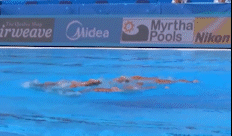
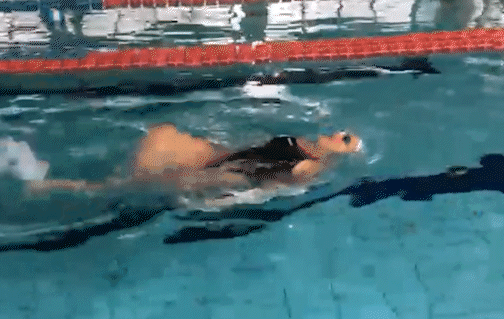
Transitions are defined as any horizontal movements along the surface with 1-2 lower limb actions that have consequential apnea (rolling over, kicking, etc.). For example, a series of ballet legs is considered a transition.
Transitions do not have any difficulty value, but they do matter as they are a category of their own on the artistic impression panel.
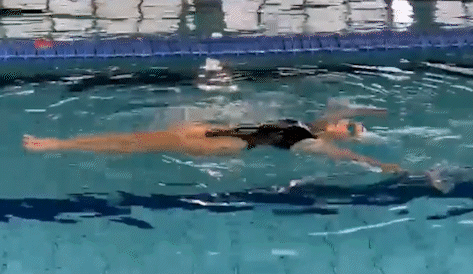
A free hybrid’s Degree of Difficulty value is based on three components: Base Mark, Families of Movements, and Bonuses. To obtain the final DD, one only needs to add up the numerical values of these three parts.
The Base Mark
UPDATE: As of June 14, the Base Mark has been redefined and does not take into account TU and NM anymore. All free hybrids have a base mark of 0.5, and that value is not taken into account in the DD. Everything mentioned below related to the BM is still relevant for every competition held before that date. Please refer to the update here.
The Base Mark (BM) is the difficulty value that a hybrid has according to the time spent underwater (TU) and the number of movements performed (NM). These two parameters are common to every possible hybrid. The base mark is the lowest possible difficulty value a free hybrid can receive.
BM = NM + TU
There are four possible levels for Number of Movements in a hybrid:
| Level 1 (NM1) | 6 movements or less |
| Level 2 (NM2) | 7-19 movements |
| Level 3 (NM3) | 20-29 movements |
| Level 4 (NM4) | 30+ movements |
Time Underwater is split in three levels:
| Level 1 (TU1) | 6 seconds or less |
| Level 2 (TU2) | 7-15 seconds |
| Level 3 (TU3) | 16 seconds and longer |
Each of these levels has been assigned a numerical value, ranging from 0.05 (level 1) to 0.3 (level 4). The highest possible Base Mark is 0.5 (NM4 + TU3).
In duet, mixed duet and team, athletes can do different numbers of movements or record a slightly different time spent underwater. However, these all have to be at the same level. For example in a team hybrid, if four athletes do 12 movements and the other four do 15, it is permitted as everything is NM2. However, if half do 29 movements and the other half 32, that is not permitted.
In any case, if a difference in levels is spotted, then the lower NM or TU level will be applied. In the last example, the whole hybrid would only be awarded NM3, and not NM4.
Overall, the base mark is a very significant component of this new scoring system. Undoubtedly, it will come up a lot at competitions, on scoresheets, and on TV broadcasts as it may be the main reason why a seemingly very strong routine suddenly finds itself in seventh place.
Indeed, a free hybrid can only be credited two values: its full DD or its BM. When a free hybrid is not completed as declared on the Coach Card (we’ll get to that), it will receive its BM value. Since that will inherently be much lower than the intended DD, it will hurt the athlete’s total, even if the execution score was high. It’s not a zero, but it will sting just as much.
(Please note the Connection values have been updated by Inside Synchro according to the changes mentioned in the addendum – Item #7.)
Families of Movements
There are five families of movements that can make up a hybrid. Each family has different levels of difficulty, ranging from Level 1 to Level 9, although only Thrusts and Rotations go up to the latter at this time.
- Thrusts (T1 – T9)
- Rotations (R1 – R9)
- Flexibility (F1 – F6)
- Airborne Weight (AW1 – AW7)
- Connections (C1 – C6)
Just like for the Base Mark, all of these levels have numerical values. Naturally, the higher the level, the higher its value.
Each level per family includes a variety of choices and movements, all detailed in the guidebook. For example, R4 includes spin ascending 720°-1080° (one or two legs), spin descending 720°-1440° (one or two legs), and twist 360° with two legs. All are worth 0.55.
As you will notice on the difficulty table, not all levels across the families are valued equally. For example, a Thrust Level 6 (T6) is worth 0.5 while a Rotation Level 6 (R6) is at 0.65, and a Flexibility Level 6 (F6) is at 0.3.
Out of the five families, the Rotations are the most highly valued. So, be prepared to see a lot of them, and even more so as R5 – R9 do not have a limit of reps per hybrids. That said, rotations are also the riskiest ones and most likely to lead to base marks as the turns must be fully completed as declared.
It isn’t required to display each of the five families in one hybrid, or even in the whole routine. For example, it is fine if none of the hybrids include a Thrust movement. A routine may also contain only hybrids from the same families, but this lack of variety may be reflected in the “Choreography and Musicality” score in the artistic impression panel.
However as already alluded to, there is a limited amount of reps one can declare of each family per hybrid. For example, a coach can only declare two Flexibility movements in each hybrid. That said, some measures have been taken to introduce variability in the hybrids.
In teams or duets, when a hybrid movement or bonus action (we’ll get to that too) is not performed by all athletes, its value will be factored by *0.5 (half of swimmers included) or by *0.3 (less than half of swimmers included). This factorization thus allows coaches to declare an extra movement if it is also factored.
Obviously, it is also possible to do two movements from different families simultaneously, but only one can be declared. It is up to the coach to determine which is worth more or most likely to be completed.
Moreover, Rotations and Connections already have the Airborne Weight needed to perform the movement taken into account. So, a coach cannot double declare R/C and AW for the same movement. In the same way, if two Rotations have been declared and a third rotation is performed, the Airborne Weight of the third rotation can be declared, but not as a third Rotation (this is only applicable to R1-R4, which can be declared twice per hybrid).
Still with me? Alright. The process to calculate a free hybrid’s DD doesn’t end there. A handful of bonuses have been implemented to further increase the difficulty value.
Bonuses
UPDATE: As of June 14, the Angles bonus has been removed, and the Pattern Change bonus does not include two different kinds. A PC is now worth 0.3. Everything mentioned below related to the Angles and Pattern Change bonuses is still relevant for every competition held before that date. Please refer to the update here.
There are five kinds of bonuses, but not all are applicable to every event:

- Traveling: This bonus is applied if the swimmer(s) moves at least 1 meter or more during the hybrid. It doesn’t count if traveling occurs at the entry or exit of the hybrid.
- Angles: This bonus pertains to the angles of the legs in the hybrid. It can be simple (A-S) or complex (A-C). Each hybrid must have two or more different angles for the bonus to be credited.
- Placement: This bonus will be awarded (per hybrid) if one or more hybrids are performed in the last 20 seconds of the routine.
- Synchronization: This bonus is split into two categories: Part Synchronization (SY-P) or full synchronization (SY-F). SY-F occurs when all eight athletes do the whole hybrid together, and is obviously worth more. However, it will only be given if the number of movements (NM) is at least Level 2.
- Pattern change: Each pattern change within a hybrid is counted either as simple (PC-S) or complex (PC-C). A simple pattern change occurs when athletes can see each other, and thus control the accuracy of the pattern. A complex pattern change includes blind pattern changes, or going from large to compact patterns, and vice versa.
Like with the families of movements above, a declared bonus not properly done or completed will lead to base mark.
What happens during a competition?
UPDATE: As of June 14, the construction of a hybrid’s difficulty has been modified. The total DD is only based on Family of Movements and Bonuses. Everything mentioned below related to the DD is still relevant for every competition held before that date. Please refer to the update here.
Prior to a meet, every coach has to submit a Coach Card for every single routine. These Coach Cards detail each Element (TRE, free hybrid, acrobatics) and transitions in order of appearance. They also list each DD when applicable. Coaches can’t change the difficulty of a routine before the preliminary events, but they can between preliminaries and finals as long as they submit a new Coach Card beforehand.
Below is what a filled-in Coach Card looks like for a free team routine. As a reminder, a free team routine must include a maximum of 11 Elements: seven free hybrids and four team acrobatics.
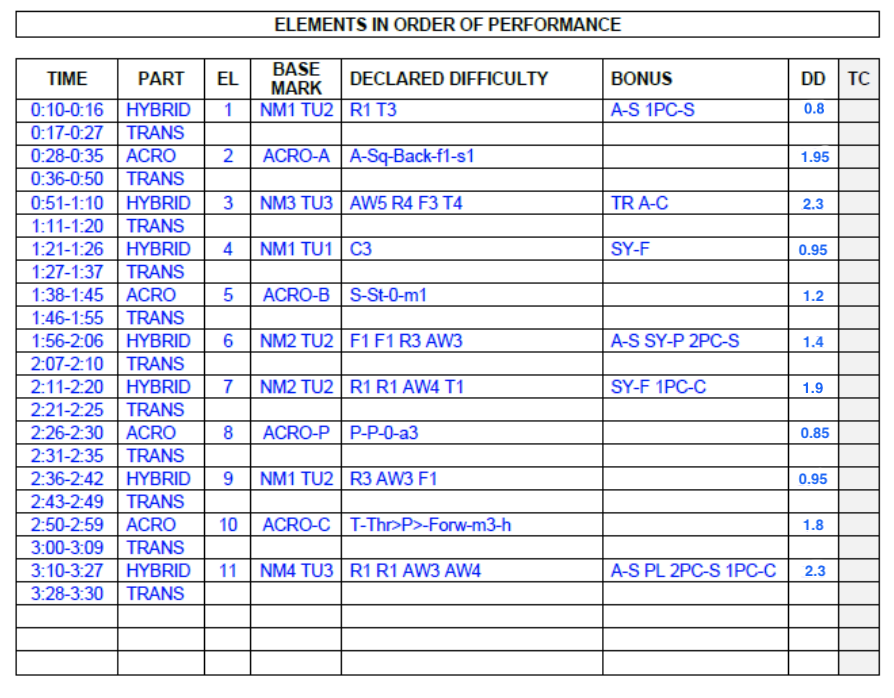
Let’s just go through the first hybrid together using the hybrid difficulty table.
BM = NM1 TU2 = 0.05 + 0.1 = 0.15
Movements = R1 T3 = 0.15 + 0.35 = 0.50
Bonuses = A-S 1PC-S = 0.05 + 0.1 = 0.15
DD = 0.15 + 0.50 + 0.15 = 0.80
At each competition, at least two Difficulty Technical Controllers (DTC) will be in charge of checking the DD values. With the help of the Coach Cards, they can “read” the routine and know exactly what should happen when.
In real time, the DTCs will verify that all Elements declared on the Coach Card and their DD match what is performed. If they notice a difference, they will flag it. Once the routine is over, the DTCs will do a video review of the Elements that were flagged.
If the discrepancy is confirmed, there are two possibilities. In the case of a free hybrid or an acrobatic, the full DD will not be credited and the BM will be awarded instead. In the case of a TRE, it will go to zero, just like in the previous code of point. If after the video review, the DTCs determines that the Element was actually completed correctly, then the full DD will be credited.
In case an error is detected in the Base Mark, the DTCs will recalculate it. An error in the base mark declaration will however not lead to the whole hybrid going to BM. Moreover, the DTCs will not recalculate the “new” DD. The difficulty value will never be upgraded or downgraded, as there is simply not enough time to do that during a meet. Once again, the free hybrid will receive either its full DD or its BM.
In the end, the difficulty of a hybrid isn’t everything, but it undeniably weighs a lot. Obviously, having high DD values is also riskier and more BM-prone, so it is ultimately up to the coaches and athletes to strategize properly.
Another important matter is that the execution score that judges can give to an Element now has a limit based on height. It doesn’t matter if the swimmers show great extensions, are perfectly synchronized, or are very sharp and strong in their movements if they lack the height and are only just above the knees. They should score a maximum of 6.0 in execution for that Element.
So, it is possible to have a very good team that tries to have high DD values in its hybrids. But if they miss the height in the movements, they will drastically go down in their execution scores. What’s truly worth it? Increase the difficulty to a level 5 but lose two points in execution?
If you have any further questions on the DD of free hybrids or anything else related to the new rules, leave them in the comments below or send us a message via our contact page. We will try to answer them all in Q&A article will be published after the first World Cup leg.
ARTICLE BY CHRISTINA MARMET
Cover photo: Deepbluemedia
If you’ve enjoyed our coverage, please consider donating to Inside Synchro! Any amount helps us run the site and travel costs to cover meets during the season.

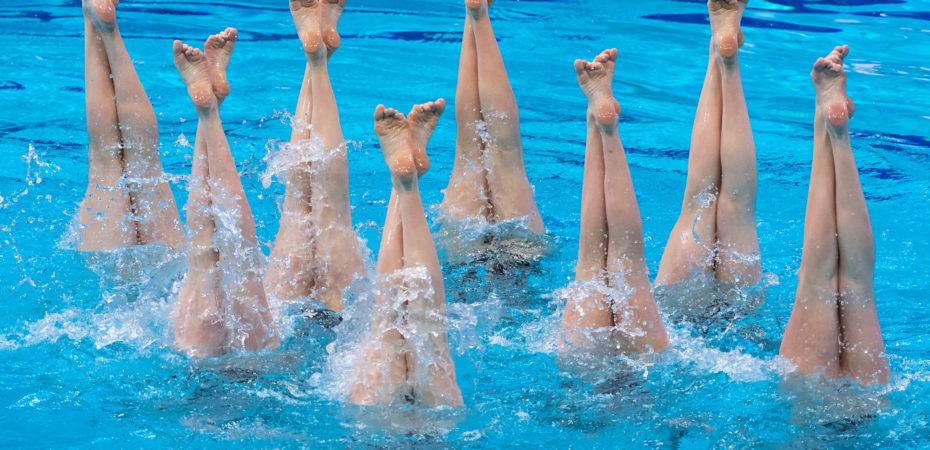
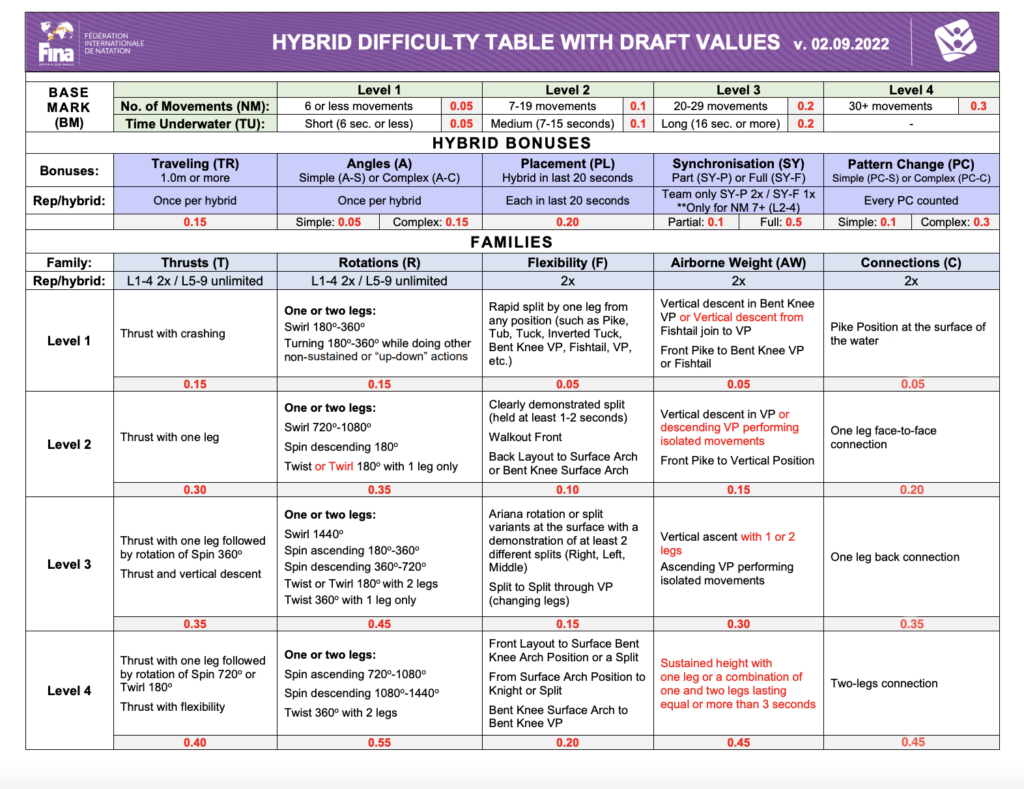
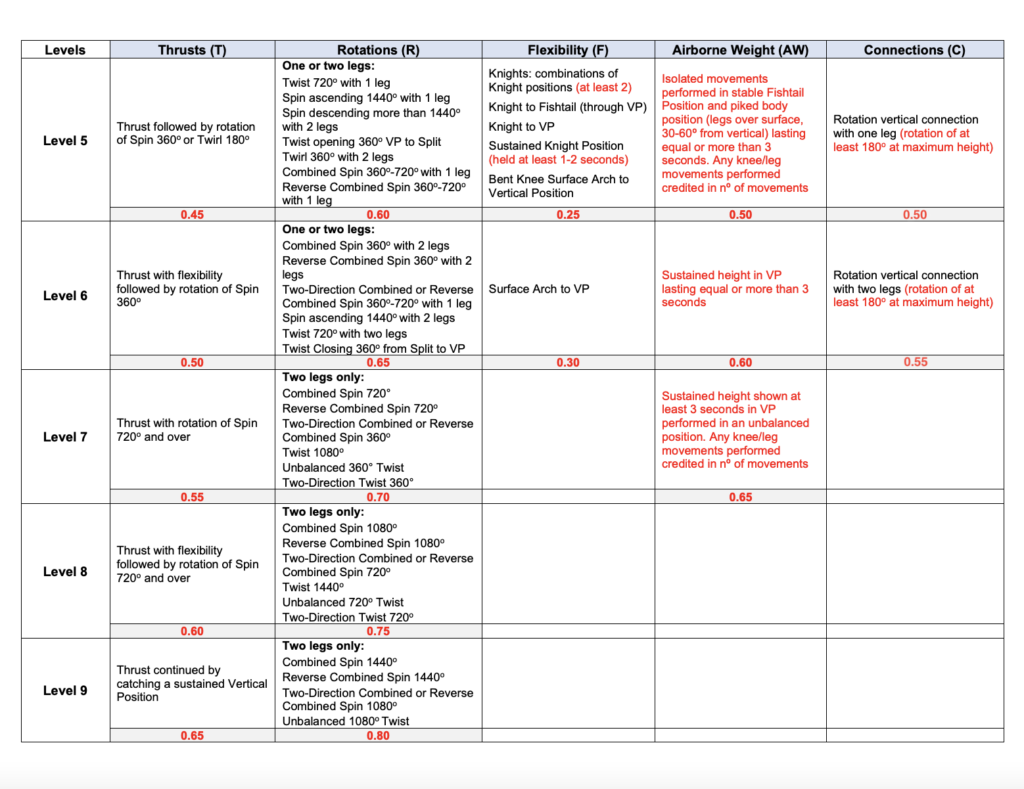
It seems to mean that less routines will display swimmers doing different things during hybrids.. And i guess that is why they stopped free combo. Wont it advantages technical routines over artistic ones ? It feels like to get the maximum points, a lot of “useless” movements (according to the scoring system) won’t be swim in a competition anymore..
I agree. From the meets I’ve watched so far, it’s indeed very repetitive and all are doing the same things. Lots and lots of rotations. It will take a while to calibrate everything, and hopefully for artistry to matter just as much. Because for now, it’s definitely in the back of everyone’s minds.